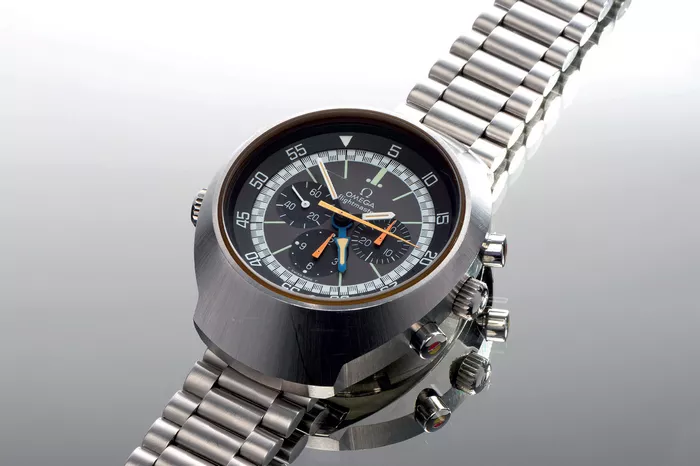The Omega Flightmaster stands as a distinctive and iconic timepiece in the Omega lineup, known for its aviation-inspired design and functionality. Introduced in the early 1970s, the Flightmaster quickly gained popularity among pilots and watch enthusiasts alike. In this comprehensive review, we delve into the key features, design elements, historical context, movement prowess, and collector’s allure of the Omega Flightmaster.
1. A Nod to Aviation Heritage: Design and Inspiration
The Omega Flightmaster was designed with the needs of professional pilots in mind. Its bold and purposeful design includes a unique asymmetrical case, large chronograph pushers, and a prominent red-orange central minute hand for easy legibility during flight. The watch exudes a vintage charm, capturing the essence of the 1970s and the golden age of aviation.
2. Triple Chronograph Functionality: A Pilot’s Essential Tool
At the heart of the Flightmaster is its triple chronograph functionality, allowing pilots to measure elapsed time, record additional intervals, and synchronize with absolute precision. The distinctive layout of the sub-dials, including a 12-hour register and a 24-hour indicator, adds to the watch’s complexity and usefulness for aviators.
3. Dual Crowns and Rotating Bezels: Intuitive Operation
One of the standout features of the Flightmaster is its dual-crown design. The upper crown operates the inner rotating bezel, which can be used to track a third time zone or serve as a countdown timer. The lower crown is used for time setting and winding the movement. This dual-crown configuration adds to the watch’s unique aesthetics and functionality.
4. Caliber 910 Movement: Robust and Reliable
Powering the Flightmaster is the Omega Caliber 910, a manual-winding chronograph movement known for its robustness and reliability. The movement features a 24-hour indicator, allowing wearers to distinguish between day and night easily. While the Caliber 910 may lack the automatic winding found in some contemporary watches, its durability and precision make it a trusted companion for pilots and enthusiasts.
5. Materials and Variations: Stainless Steel and More
The Flightmaster is primarily crafted from stainless steel, providing durability and a timeless aesthetic. Various iterations of the Flightmaster exist, with differences in dial colors, bezel designs, and case materials. Vintage models, particularly those with a patina on the dial, are highly sought after by collectors.
6. Collector’s Appeal: Rarity and Vintage Charm
Due to its limited production and distinctive design, the Omega Flightmaster has become a coveted piece among watch collectors. Vintage models, especially those from the 1970s, are increasingly rare and sought after. The Flightmaster’s unique combination of aviation history and horological innovation adds to its collector’s appeal.
7. Evolution and Legacy: From the 1970s to Today
While the original Flightmaster was produced for a relatively short period in the 1970s, its legacy lives on through modern reinterpretations and tributes. Omega has occasionally released limited editions inspired by the Flightmaster’s design, ensuring that its influence on aviation-themed watches endures.
Frequently Asked Questions (FAQs)
Q1: Is the Omega Flightmaster suitable for everyday wear?
While the Flightmaster’s bold design may make it less suited for formal occasions, it can be worn daily by enthusiasts who appreciate its vintage charm and aviation-inspired aesthetics.
Q2: Can the bezel on the Flightmaster be used for tracking a third time zone?
Yes, the inner rotating bezel on the Flightmaster can be used to track a third time zone, adding to the watch’s functionality for frequent travelers or individuals working across different time zones.
Q3: Is the Flightmaster water-resistant?
The original Flightmaster was not designed with a high level of water resistance. While it can withstand occasional splashes, it is advisable to avoid water exposure to preserve the watch’s condition.
Q4: Are there modern versions of the Omega Flightmaster available?
Omega has released modern interpretations and tributes to the Flightmaster, incorporating contemporary materials and movements while staying true to the original design. These modern versions offer enthusiasts a chance to experience the Flightmaster’s charm with updated features.
Q5: What is the significance of the orange minute hand on the Flightmaster?
The orange central minute hand on the Flightmaster serves both a functional and aesthetic purpose. It enhances legibility during flight, and its vibrant color adds a distinctive touch to the watch’s overall design.
Q6: How often does the Caliber 910 movement in the Flightmaster need servicing?
Regular maintenance checks by authorized Omega service centers are recommended for the Caliber 910 movement. The frequency of servicing depends on usage and wear but is generally advised every 4-5 years.
Q7: Are vintage Flightmasters with a patina desirable among collectors?
Yes, vintage Flightmasters with a patina on the dial are highly desirable among collectors. The patina adds character and a sense of authenticity to the watch, reflecting its age and history.

